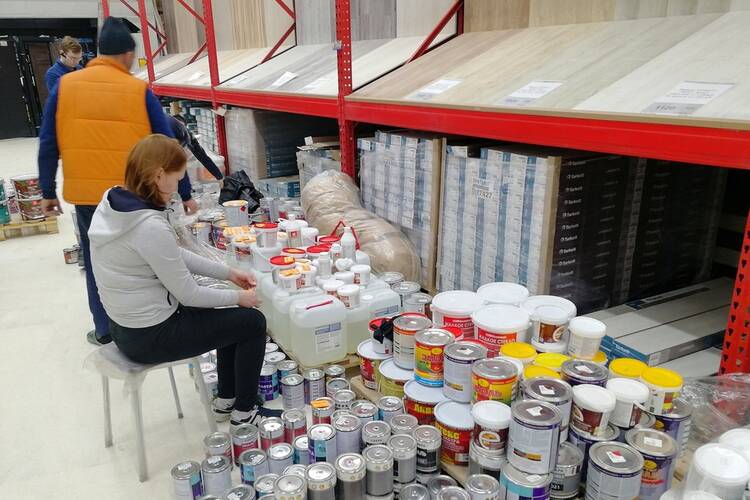
When it comes to starting any merchandising-related business, your options are vast.
This is because merchandising spans across industries and product types, offering endless opportunities to creatively display, organize, and promote goods to attract customers and increase sales.
A well-planned merchandising strategy can set your business apart, influence buying decisions, and significantly boost customer satisfaction and retention.
Hardware stores thrive on functionality, convenience, and organization, so your merchandising must reflect those principles.
If you are looking to open a hardware store and need merchandising ideas, we will explore some of the most effective and practical merchandising ideas tailored for hardware retail.
From product placement and signage to seasonal promotions and cross-merchandising strategies, these tips will help you create a visually appealing and customer-friendly shopping experience that drives traffic and encourages more purchases in your store.
Best Merchandising Ideas for Hardware Store
-
End Cap Displays
End caps are some of the most valuable spaces in any hardware store because they naturally catch the eyes of customers walking through the aisles.
You can use them to showcase seasonal items, new arrivals, or bestsellers such as outdoor tools in summer or snow-removal products in winter.
Refresh the displays frequently to maintain interest and create a sense of urgency.
Incorporate bold signage, helpful tips, or promotional pricing to drive impulse buys and highlight products customers might not normally seek out.
-
DIY Project Stations
Create a dedicated DIY project station that showcases everything a customer needs to complete a specific home improvement task, such as assembling a birdhouse, fixing a leaky faucet, or installing a shelf.
Display all required materials together, including tools, hardware, and accessories, to simplify the shopping experience.
Provide printed step-by-step guides and QR codes linking to instructional videos for added guidance.
These stations encourage hands-on learning, inspire creativity, and increase sales by promoting bundled purchases, especially appealing to beginners looking for practical, manageable projects.
-
Cross-Selling Zones
Strategically position related products together to make shopping more intuitive and to encourage additional purchases.
For instance, place paintbrushes, rollers, and painter’s tape right next to your selection of paint cans, or group extension cords with power tools.
This cross-merchandising approach helps customers easily identify what they’ll need for a project, reducing return trips and boosting convenience.
Highlight these groupings with signs like “Don’t Forget” or “Frequently Bought Together.”
Offering bundle discounts or multi-buy deals can further increase average transaction value and customer satisfaction.
-
Seasonal Product Rotation
Keep your store dynamic and relevant by regularly updating displays to align with the current season or upcoming holidays.
For example, showcase heaters, weather stripping, and insulation kits as temperatures drop in the fall, then switch to snow blowers, ice melt, and salt during winter months.
This seasonal rotation not only helps clear out inventory but also meets customers’ immediate needs.
By anticipating seasonal demands and featuring timely products, you encourage repeat visits and position your store as a go-to resource throughout the year.
-
Impulse Buy Bins at Checkout
Place small, affordable items such as batteries, measuring tapes, utility knives, and keychains near the checkout area to capture customers’ attention during their final moments in the store.
These impulse-buy displays encourage last-minute add-ons that increase overall sales without much effort from shoppers.
Keep these bins neat, clearly labeled, and easy to browse, so customers can quickly find something useful or tempting.
Regularly rotate the selection every few weeks to introduce new products and keep the display fresh.
-
Organized Tool Wall
Design a clean, organized tool wall that showcases a variety of essential hand and power tools like hammers, drills, screwdrivers, and wrenches.
Use pegboards and sturdy hooks to keep items visible and easily accessible for customers to browse.
To further assist customers, highlight popular products or staff favorites with “Top Choice” or “Best Seller” labels, providing trusted recommendations that simplify the decision-making process and boost sales.
-
Demo Stations
Interactive product demonstration stations give customers the chance to physically try out tools and equipment before purchasing, which greatly enhances their shopping experience.
Having knowledgeable staff on hand to showcase proper usage and safety precautions, especially for power tools and complex machinery, builds customer trust and confidence.
These demos help customers feel more comfortable with their potential investment, often leading to quicker purchasing decisions.
This hands-on approach not only educates shoppers but also highlights product features and benefits, increasing the likelihood of sales, particularly for higher-priced items.
-
How-To Video Kiosks
Set up tablets or digital screens strategically placed around the store that continuously play short how-to videos featuring popular projects and product demonstrations.
These videos can cover tasks like installing a faucet, using a cordless drill, or assembling furniture, providing customers with helpful, visual instructions.
This interactive, multimedia approach not only enhances the shopping experience but also encourages customers to purchase the related tools and materials showcased in the videos.
-
Loyalty Rewards Product Shelf
Set aside a prominent shelf or display area exclusively for products that customers can earn or redeem through your store’s loyalty program.
Featuring desirable items here incentivizes shoppers to join and actively participate in the rewards system.
Regularly rotating the featured rewards keeps the selection exciting and encourages repeat visits as customers seek to redeem their points.
Promote the loyalty program benefits clearly throughout the store using signs, flyers, and staff recommendations to maximize awareness and engagement.
-
Clearance and Bargain Corner
A well-organized clearance section appeals to bargain hunters looking for deals on slow-moving or seasonal items.
Mark this area with bold signage and keep it clean and tidy to create a positive shopping experience.
Regularly update price tags to reflect discounts and ensure customers can easily identify savings.
Position the clearance corner in a location that’s accessible but doesn’t obstruct main traffic flow, allowing shoppers to browse comfortably.
This strategy not only helps clear inventory but also attracts budget-conscious customers.
-
Vertical Merchandising
Maximize your store’s space by installing vertical shelving units along walls to display bulky or long items such as ladders, extension cords, and plumbing supplies.
Vertical storage frees up valuable floor space, making aisles less crowded and improving the overall shopping environment.
Organize products by size, type, or function to help customers find what they need quickly.
Use clear, easy-to-read signage to guide shoppers and highlight key product features.
This approach improves visibility, accessibility, and encourages efficient browsing, ultimately boosting sales and customer satisfaction.
-
Expert Tip Tags
Enhance product appeal by attaching informative cards with expert tips and recommendations from local professionals or your knowledgeable staff.
For example, a power drill might have a tag saying, “Ideal for DIY beginners, lightweight yet powerful.”
These personalized notes provide valuable insights, helping customers understand the product’s best uses, benefits, and suitability for different skill levels.
This added information builds trust, reduces purchase hesitation, and empowers shoppers to make confident decisions.
-
New Arrivals Spotlight
Create a dedicated, eye-catching section in your store specifically for newly released or trending hardware products.
Use bold “Just In” signage and focused lighting to make this area stand out and attract customers’ attention as soon as they walk in.
Regularly update this space with the latest innovations and popular items to keep your inventory fresh and exciting.
By showcasing new arrivals prominently, you encourage repeat visits from customers eager to discover what’s new.
-
In-Aisle Signage with Use Cases
Implement clear, informative signage throughout your store that explains the specific uses and benefits of products.
For example, in the fasteners aisle, place signs like “Best for Hanging Heavy Mirrors” or “Ideal for Outdoor Use” to guide customers in selecting the right item for their project.
These detailed descriptions minimize confusion, reduce the need for staff assistance, and speed up the decision-making process.
By making product purposes transparent and easy to understand, you enhance the shopping experience and increase the likelihood of correct, satisfying purchases.
-
Mobile App Integration with QR Codes
Integrate QR codes next to popular or technical products that link customers to valuable online resources such as customer reviews, detailed specifications, and step-by-step how-to videos.
This digital integration caters to shoppers who prefer researching products before making a purchase, providing them with immediate access to trustworthy information.
The interactive experience boosts confidence in their buying decisions and demonstrates your store’s commitment to customer education.
By blending physical shopping with online content, you create a modern, engaging environment that meets the needs of today’s informed consumers.
-
Contractor Corner
Create a dedicated “Contractor Corner” designed specifically for professional builders and tradespeople.
Stock this area with bulk quantities of essential materials, heavy-duty tools built for job-site durability, and specialized equipment that contractors frequently need.
Include business cards or flyers for local trade services to foster community connections.
To build loyalty and encourage repeat business, offer exclusive discounts, volume pricing, and early-bird shopping hours tailored to busy professionals.
-
Safety Equipment Display
Establish a marked, easily accessible safety equipment section featuring essential personal protective equipment (PPE) like gloves, goggles, hard hats, and masks.
Use bold signage to highlight workplace safety guidelines and relevant regulations, reinforcing the importance of proper protection.
Design this area as a convenient one-stop shop for both professionals and DIY homeowners, ensuring customers can quickly find everything needed to stay safe on the job or at home.
-
Kids’ DIY Corner
Create a dedicated kids’ DIY corner stocked with safe, age-appropriate kits like wooden models, simple tool sets, and craft projects designed to spark creativity and hands-on learning.
Include a small bench or table area with coloring sheets, project instructions, or interactive activities to keep children entertained while parents shop.
This family-friendly space not only encourages parents to bring their kids along but also introduces younger generations to DIY skills early on.
By fostering positive experiences, you build long-term customer loyalty and enhance your store’s welcoming atmosphere.
-
Local Product Feature
Set aside a special display area for locally made products and brands, showcasing goods crafted or sourced from your region.
Highlighting local businesses fosters community pride, strengthens customer connections, and supports the local economy.
Enhance this section with photos, stories, or bios of the artisans and manufacturers to add a personal, authentic touch that resonates with shoppers.
By celebrating local craftsmanship, you not only differentiate your store’s offerings but also build goodwill, encouraging customers to support hometown businesses and promoting a sense of community involvement.
-
Live Workshop Schedule Display
Prominently feature a wall calendar or vibrant LED signboard near your store entrance or customer service area to advertise upcoming in-store classes and workshops such as plumbing basics, tile setting, or tool safety.
Regularly update this schedule to keep customers informed and engaged. Highlighting educational events positions your hardware store as a valuable community resource that goes beyond selling products.
These interactive sessions build customer trust, encourage repeat visits, and foster a loyal customer base eager to learn new skills.
